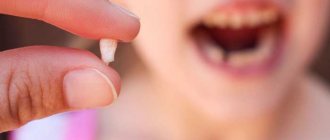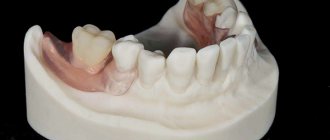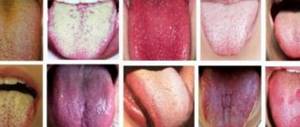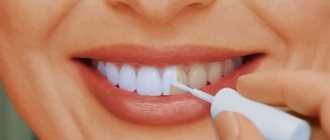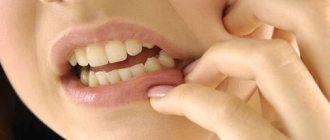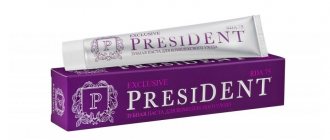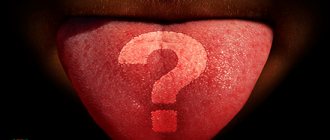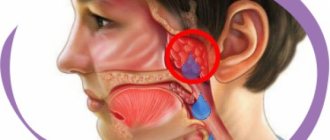Black plaque on teeth, or Priestley's plaque, occurs for various reasons. It may indicate caries, gastrointestinal problems, enamel diseases, or simply poor oral hygiene. It often appears in children aged 2-3 years. In this article we will tell you what to do if your child’s teeth become black.
In this article
- Black plaque on children's teeth: causes of formation
- A child has black teeth - what to do?
- Black teeth in children: possible complications
- Other types of plaque depending on color
- Prevention of dental plaque in children
Black plaque on teeth can appear suddenly at any age, but, according to statistics, it is 8-10 times more common in children. It looks like an uneven border of a dark color, almost black, running along all the teeth closer to the gums. In rare cases, it appears as a small spot or blackhead, often forming on the inside of the teeth.
This symptom is also called Priestley's plaque in honor of the scientist who first described it. He also named the possible reasons for its formation. The danger to health is not so much the plaque itself, which is not a pathology, but a symptom, but rather the disease that provoked its appearance.
CAUSES OF PLAQUE IN CHILDREN
Darkening of the tooth surface can cause:
- Parasites are a common cause of darkening of the enamel.
- Heredity, although extremely rare, is a possible cause of deviation from the norm in enamel color.
- Abnormalities in the functioning of the thyroid gland or diabetes mellitus cause a number of inconveniences to our body, one of the consequences of such diseases is the occurrence of Priestley's plaque.
- Malocclusion. Plaque occurs due to improper chewing of food. Especially, the oral cavity has one working side.
- Sweets.
- The immune system does not always cope with its responsibilities and sometimes this is the reason for the development of bacteria in the body.
- A lack of calcium most often manifests itself in the form of dark teeth.
- There are diseases due to which the enamel does not develop completely, so the teeth lose their healthy appearance.
- Caries is more a consequence of Priestley's plaque than a cause, but there are also cases when dark spots appear on all teeth due to caries.
- If you do not brush your teeth in time, food remains remain, particles of which settle on the teeth. Each of the reasons is dangerous in its own way, sometimes it will be enough to go to the dentist to get rid of dark spots, and sometimes black spots are only signals of more terrible problems (if we are talking about diabetes or problems with the thyroid gland).
The plaque must be removed immediately, because... If you don’t deal with this problem quickly and take care of your teeth, it will become firmly attached to the enamel and it will be difficult to remove the darkening. When choosing a paste, you need to pay attention to the components. The main criterion is that the paste should not contain fluorine or be present in small quantities, because this element can lead to darkening of the enamel (incisors are most often affected).
How to get rid of white spots on teeth
First of all, it is important to consult a doctor to find out the causes of the unpleasant symptom. The pediatric dentist will determine what caused the whitish formations on the teeth, select effective therapeutic methods, and give recommendations for high-quality hygienic care and prevention.
If a carious lesion is detected at the initial stage, no serious intervention is required. In most cases, it is sufficient to use silvering (on primary occlusion), remineralization or ozonation (in the presence of permanent rows). The baby must be taught proper hygiene.
When caries is deep and painful, you cannot avoid using a drill and installing filling material. When the pathological process is advanced, depulpation and even extraction (removal) are indicated.
If an excess of fluoride is detected in a child’s body, the doctor will advise using a paste that does not contain this component. Remineralization is also indicated.
When tooth surfaces become white due to braces or other orthodontic structures, complex treatment is carried out, which includes:
- elimination of carious cavities;
- disinfection;
- replacement of simulators with new ones;
- regular dental monitoring;
- professional cleaning of food debris and accumulated plaque.
DIAGNOSTICS
Priestley's plaque itself is not dangerous to the body, but dark spots can also occur for other reasons. Therefore, you should always rule out risks and check with a dentist.
In cases where a stain appears on a tooth, diagnostics is carried out using a laser. This helps the specialist determine how deep the caries has spread, as well as its stage. After diagnosis, individual treatment is prescribed based on the data obtained.
If the dark plaque was not caused by caries, the specialist will prescribe additional tests that will identify the problem.
HOW TO TREAT DENTAL PLAQUE
You won't be able to get rid of dark plaque at home. There are many products and special toothbrushes that promise to cope with the problem. But they are not able to eliminate darkening in the enamel itself. Going to the dentist is the only solution.
Depending on the factors that caused the darkening of the enamel, treatment should be prescribed:
- Caries, if it is in its early stages, is sometimes frozen with the help of means that protect the teeth. This procedure is carried out to wait for the teeth to change without damaging the enamel.
- If the darkening occurs due to a lack of any substances in the body, the specialist will prescribe a diet to restore balance in the body.
- In case of disturbances in the gastrointestinal tract, special procedures will be prescribed, as well as a diet. Depending on the problem, the doctor will give individual recommendations.
Professional teeth cleaning is not recommended for children with baby teeth. If the doctor does prescribe treatment, he will use laser cleaning to clean all the teeth. For baby teeth, the effect is likely to be permanent. In adults, plaque may return even after using a laser.
ENAMEL WHITENING PRODUCTS
It is impossible to rid your teeth of dark plaque without the help of specialists, because these are not simple darkening, but the consequences of bacterial growth. But if you stick to proper nutrition, you can improve the condition of your teeth.
Be sure to include these foods in your diet:
- Cheese. Hard varieties of cheese are able to maintain the level of acids in the oral cavity. And the calcium contained in this product strengthens tooth enamel.
- Fruits. It is difficult to list the entire number of microelements that are included in the composition of the fruit. All of these microelements are important for maintaining dental health.
- Leafy vegetables. In addition to the obvious benefit in increasing immunity, when chewed, microscopic remains of vegetables remain in the oral cavity that actively fight pathogens and cleanse the oral cavity
- Water. Dehydration can play a cruel joke on the body, and due to a lack of water, problems with the gums and then with the enamel begin in the oral cavity.
To maintain dental health, you need to limit your consumption of:
- coffee;
- sweets;
- sour and fatty foods.
PREVENTION
Starting from the appearance of the first tooth, you need to start taking care of oral hygiene. Many parents do not suspect that plaque can begin to form even if the child only has one or two teeth in his mouth. For brushing teeth there is a special children's brush, which the parent places on his fingers. Its advantage is that in addition to cleaning, it massages the gums. You can replace such a brush with thick cloth or ordinary gauze. It is recommended to use baby toothpaste from 12 months.
If we are talking about an older child, he should be instilled with a culture of caring for his body and health, including the oral cavity. Many parents have the habit of feeding their child and licking the spoon in the process. This is absolutely impossible to do, because... An adult has a lot more bacteria in his mouth, which can easily be passed on to a baby. The child should have his own plate and his own spoon, which only he can use!
There is a concept called “bottle caries.” The fact is that the baby’s body produces little saliva at night and it cannot cope with bacteria that enter while drinking from the pacifier at night. Babies often grab bottles with dirty hands; it is recommended to replace nipples with baby cups at the first opportunity.
The child should be taken to the dentist for the first time at 9 months, the next scheduled examination will be in three months. After a year, visits to the dentist should be at least once every six months. To maintain the appearance of your teeth, you can perform hygienic teeth cleaning in the clinic; this procedure also prevents the occurrence of caries.
PLAQUE IN ADULTS
Adults also face the problem, and for them this is an alarming sign, because... More often than not, plaque does not occur just like that (unless we are talking about a complete lack of hygiene).
Causes of dark enamel in adults:
- People working in hazardous industries face oral problems. Particles of heavy metals can enter the mouth during work, where they accumulate and cause significant damage to both tooth enamel and gums.
- Frequent use of antibiotics can cause tooth enamel to darken. This process is a side effect of tetracycline drugs, and it can be very difficult to get rid of it.
- Some products containing chemicals can have negative effects on the body, including deterioration of the enamel.
- Due to poor nutrition, black spots appear on the teeth.
- Severe viral infections and chronic diseases, especially those related to the gastrointestinal tract or liver, can cause black plaque to appear on the inside of the teeth.
- Plaque is more likely to occur in people who smoke, as well as those who regularly drink coffee or strongly brewed red tea. The dark color of teeth occurs because the nicotine resin becomes compacted into the enamel. If you do not get rid of dark spots on your teeth in time, they will turn into stones, causing even greater aesthetic discomfort for an adult.
- Drug use leads to destruction of the entire body, including teeth.
- There are cases when the wisdom tooth grows out already blackened. This may be due to a mummified nerve or damage to the pulp.
While a child with baby teeth does not always need to remove dark plaque, this procedure is mandatory for an adult. In cases where the process of darkening the enamel has just begun, abrasive pastes will help. It is enough to brush your teeth with an abrasive paste once a week to restore your teeth to their former healthy appearance. Only a dentist can help with more serious darkening.
Most common questions
Why do blackened teeth erupt in infants?
Blackened teeth in a newly born baby indicate an unhealthy lifestyle of his mother during pregnancy.
What prenatal factors could have caused the problem?
The most common causes of dental pathology are:
- unbalanced diet, lack of calcium and other minerals;
- smoking;
- taking alcoholic beverages, potent medications;
- chronic or past infectious diseases;
- genetic predisposition.
METHODS FOR REMOVAL OF PRIESTLEY'S PLAQUE
The simplest method is to use water with soda, which saturates the tissues with fluoride. Using this procedure, it is easy to remove gray plaque. The big disadvantage of this method is the thinning of the enamel, so after the procedure you need to treat the oral cavity with special treatment. means for protecting teeth.
LASER
Laser does not injure gums and enamel.
This method is performed in three steps:
- The doctor performs preparatory cleaning of the oral cavity.
- Using special equipment, plaque is removed, the remains of which are subsequently washed out of the oral cavity using an air-water jet.
- The teeth are ground and polished using special. nozzles And at the end they are treated with a product containing fluoride.
This procedure is completely harmless and the additional effect is that the laser promotes the healing of wounds on the gums and destroys infections in the mouth.
ULTRASOUND
Ultrasound - it can be used to remove any types of stains on enamel. This procedure is more popular because... its price is lower than laser cleaning. Ultrasonic cleaning is carried out using special equipment. a device whose tip pulsates when it comes into contact with the enamel, causing it to begin to vibrate and destroy the plaque.
FOLK REMEDIES
In cases where the darkening of the enamel is insignificant, folk remedies will help:
- Lemon zest. Once a week, you can wipe your teeth with lemon zest; due to fruit acid and oil, there is a slight cleansing effect on tooth enamel.
- Soda. Once a week you can brush your teeth with baking soda (just sprinkle it on your brush and clean your mouth with light, habitual movements).
- The eastern folk method suggests replacing the usual toothbrush with an oak twig with a split tip, and instead of toothpaste using a mixture based on salt and drops of vegetable oil.
PRODUCTS THAT PROMOTE PLAQUE
- Spices and sauces. These products are harmless to teeth, but some of them contain dyes that are deposited in the micropores of the enamel. Some sauces contain a large amount of acids that can soften the enamel, which will lead to its darkening.
- Carbonated drinks. They contain a large number of harmful dyes. Some of them can melt tooth enamel. Due to their frequent use, acid necrosis of tooth enamel develops.
- Berries with a high content of natural dye. Such berries include blackberries, blueberries, etc. When consumed regularly, the color of the fillings becomes discolored.
- Hard sweets (caramel). When consuming this type of sweets, a sticky film forms on the teeth, which damages the enamel and leads to the formation of dark spots on it.
- Red wine. Due to the pigment content in this drink, the color of the enamel changes. It is recommended that after drinking red wine, use a special cleaning foam or simply rinse your mouth with water.
- Coffee and strong dark tea. These drinks also contain a high content of pigments, which cause the enamel to become stained.
Symptoms of the disease
As a rule, the highest concentration of fungus is found on the surface of the inside of the cheeks, tongue, pharynx and tonsils, and palate. At an early stage of the development of the disease in children, redness of the mucous membranes is observed; they become swollen, the sensitivity of the mucous membrane increases, which is why children are often irritable, capricious, and their appetite and sleep are disturbed. The primary episode of the disease usually occurs in a more acute form; Patients may experience general symptoms: fever, headaches and dizziness, nausea or vomiting, deterioration in general health.
Some time after the onset of the disease, white grains begin to appear on the surface of the mucous membranes of the oral cavity, which gradually increase in size and merge together, forming plaques, and then plaque covering large areas of the mucosa. During this stage, patients suffer from severe dryness and swelling in the mouth. The mucous membranes become painful. Burning, itching and other unpleasant sensations are most often associated with the development of an allergic reaction caused by the proliferation of pathogenic microorganisms and the release of toxins during their life processes. The pain intensifies when eating and swallowing food, when eating hot, sour, spicy foods and drinks. Infants often refuse to eat.
The plaque formed during candidiasis has a very characteristic appearance and resembles milk films or remains of cottage cheese. It consists of destroyed cells of the mucous membranes, food debris, bacterial mass, fibrin and keratin. Flakes, scales and plaque can also appear outside the mouth - on the edges of the lips. The spread of infection to the lips is called candidiasis. Because of this disease, the skin in the corners of the lips dries out and cracks; In some cases, the infection affects the entire surface of the lips, resulting in cracking and peeling.
In mild and moderate forms of the disease, plaque is easily scraped off, and underneath it, areas of erosion (ulceration) or maceration (softening) of the mucous membrane are found. A longer course of the disease and the lack of adequate treatment leads to deep damage to the mucous membranes, as a result of which blood appears on their surface, turning the plaque brown or brownish.
RESULT
Mothers should not panic, because black plaque is a common problem for children. If you use the given recommendations about proper food and oral hygiene, there will be no consequences. If desired, plaque can be removed with the help of a dentist. But many dentists recommend waiting until the baby teeth are replaced by molars.
It is rare, but it happens that dark spots on the enamel are signs of disease (diabetes mellitus). Therefore, it is better to immediately eliminate all risks so as not to disturb yourself and your child. If we are talking about adults and not children, then you cannot put off going to the dentist. If in children plaque is a common phenomenon, which extremely rarely indicates something serious, then in adults this is completely different.
Even if Priestley’s plaque turned out to be a consequence of caries, the enamel may soon deteriorate and the teeth will begin to crumble. This problem is more serious for adults, because... molars are no longer restored. Maintaining oral hygiene and proper nutrition is an excellent prevention of dental problems.
Traditional methods
Treating plaque with natural remedies as a complementary therapy produces good results. Here are two proven recipes:
- Salt and sage powder . Take equal measures of sea salt and chopped dry sage herb. Mix them on a sheet of foil. Wrap and bake in the oven for half an hour. Use to brush your teeth every 5 - 7 days.
- Natural rinse made from sage, oak bark, calendula . Take the herbs in equal parts, pour boiling water and leave to infuse for an hour, strain the infusion. Then a small amount of salt is added. The resulting product is used to rinse the mouth every time, after brushing the teeth, so that the unpleasant odor caused by the activity of fungi and bacteria disappears, to cleanse plaque and strengthen the mucous tissue.
This is interesting ! Garlic is useful not only for colds.
It is given to young children to cleanse the oral cavity of harmful bacteria and to prevent caries. The simplest, old-fashioned way: rub it on the crust of black bread and offer it to the baby.
